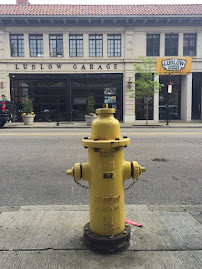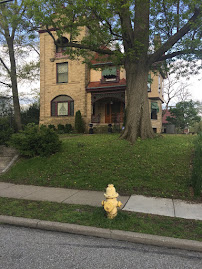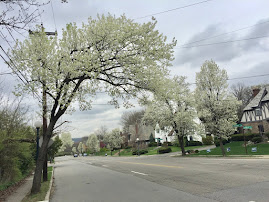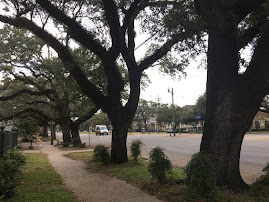Dear George,
My sister and I have a
stronger home town attachment than practically anybody else I know. I’m
not sure just why. Maybe it’s because we grew up in a small town in the
U.P. In any case, home towns
are important, providing the world of opportunities that help shape who one
becomes as a person. Recently I’ve been assembling information on
Menominee, and I’ve organized it here in the form of 36 “trivia questions”.
Some are easy, some are hard. For persons who grew up in Menominee, I
think a score of 30 would be excellent and 25 would be very good. Had I
not made the quiz up, I think I would have scored about 23. I wonder
what other natives and expatriates
might do. (Note: The answer key is given at the end.)
Love,
Dave
1. What does “Menominee”
mean in the Ojibwe language?
a. River
mouth
b. White
pines
c. Wild
rice
d. Home
of the sturgeon
2. Menominee is
located exactly halfway between:
a. Ohio
and Minnesota
b. Milwaukee
and Green Bay
c. Lake
Huron and Lake Michigan
d. the
North Pole and the Equator
3. How many streets
does the city of Menominee have?
a. 84
b. 114
c. 145
d. 219
4. The most common
national ancestry in Menominee is:
a. French
b. Irish
c. Polish
d. German
e. Swedish
5. Menominee’s
population reached its peak in:
a. 1900
b. 1930
c. 1960
d. 1990
6. Which religious
denomination has the most adherents in Menominee?
a. Catholic
b. Lutheran
c. Methodist
d. Presbyterian
7. How many acres of
parks are there in Menominee?
a. 19
b. 35
c. 82
d. 130
8. The M&M
brewery produced _____ beer.
a. Pure
Lake
b. Grizzly
Bear
c. Great
White North
d. Silver
Cream
9. The oldest church
in Menominee, dedicated in 1869, is the:
a. First
United Methodist Church
b. First
Presbyterian Church
c. St.
John the Baptist Catholic Church
d. Emmanuel
Lutheran Church
10. In which of the
following categories is Menominee significantly below the average for the
state of Michigan?
a. Unemployment
b. Foreign-born
population
c. Hispanic
population
d. All
of these
e. None
of these
11. How many state
championships have the Menominee Maroons football team won in their division
since 1998?
a. Zero
b. One
c. Three
d. Five
12. If you wanted to
have a Wabash for lunch, you would go to:
a. Schloegels
Bay View Restaurant
b. Berg’s
Landing
c. Jozwiak’s
Bar & Grill
d. The
Downtown Sandwich and Ice Cream Shop
13. Menominee’s
summer Concert in the Park series is held on which evening?
a. Wednesday
b. Thursday
c. Friday
d. Saturday
e. Sunday
14. If you went to a
movie in Menominee in 1950 you would have gone to either:
a. the
Fox or the Roxy
b. the
Lloyd or the Menominee
c. the
Bijou or the Strand
d. the
Mariner or the Waterfront
15. How many vehicles
cross the Interstate Bridge between Menominee and Marinette each day?
a. 2,490
b. 5,880
c. 11,320
d. 20,760
16. The current mayor
of Menominee is:
a. Jean
Berggren
b. Jean
Chaltry
c. Jean
Stegeman
d. Jean
Wilcomming
17. Menominee exceeds
the national average in:
a. Low
health care costs
b. Water
quality
c. Air
quality
d. All
of these
e. None
of these
18. In 2012 who
received the most votes for President in Menominee?
a. Barack
Obama
b. Mitt
Romney
19. Percentage-wise,
which occupation is more common in the city of Menominee than in the state of
Michigan as a whole?
a. Education
b. Farming
c. Healthcare
d. Production
20. The last log
drive on the Menominee River was held in:
a. 1897
b. 1907
c. 1917
d. 1927
21. What proportion
of adults (25 & over) in Menominee have a bachelor’s degree or higher?
a. 17%
b. 27%
c. 37%
d. 47%
22. The largest
employer in Menominee is:
a. L.E.
Jones Co.
b. Lloyd/Flanders
Industries
c. Angeli
Foods
d. Enstrom
Helicopter Corp.
23. In the 1940's the
Lloyd Building in downtown Menominee was occupied by the:
a. A
& P Grocery Store
b, Menominee
Glove Company
c. Montgomery
Ward department store
d. All
of these
e. None
of these
24. According to
Tripadvisor (as well as most people we know), the number one restaurant in
Menominee is:
a. Lighthouse
Grill & Diner
b. La
Cabana Mexican Restaurant
c. Berg’s
Landing
d. Thai
Cuisine
25. In a recent year
there were 536 violent crimes per 100,000 people in the state of Michigan.
In Menominee the rate was ___ violent crimes per 100,000.
a. 117
b. 239
c. 481
d. 714
.
26. Menominee High
School ranks in the top ___ in the state of Michigan.
a. 25%
b. 47%
c. 62%
d. 81%
27. The local radio
station in the twin cities of Menominee and Marinette is:
a. WBAY
b. WMAM
c. WMAR
d. WMEN
28. Which railroad
historically served Menominee and Marinette?
a. Wisconsin
Great Northern
b. Green
Bay and Milwaukee Line
c. St.
Paul and Minneapolis Railway
d. Chicago
and Northwestern
29. Does Menominee
have more churches or bars?
a. More
churches
b. More
bars
30. Which of these
Menominee County attractions is located in the city of Menominee?
a. The
DeYoung Family Zoo
b. The
North Pier Lighthouse
c. The
J. W. Wells State Park
d. The
Chip-In Casino
31. Compared to the
state of Michigan as a whole, Menominee County ranks higher than average in:
a. Adult
obesity
b. Adults
reporting poor or fair health
c. Sexually
transmitted diseases
d. Excessive
drinking
32. The wettest month
of the year in Menominee is:
a. March
b. April
c. May
d. June
33. The most common
last name of deceased Menominee residents is:
a. Anderson
b. Johnson
c. Olson
d. Smith
34. Menominee County
ranks above average for all Michigan counties in:
a. smoking
b. adult
obesity
c. alcohol-impaired
driving deaths
d. all
of these
e. none
of these
35. The Babela Master Circuit, held in
Menominee in 2005, 2008, and 2009, involves:
a. Fishing
b. Hunting
c. Snowmobiling
d. Golf
36. The website Niche
ranked Menominee #32 among 56 Michigan towns and cities in terms of the best
towns in Michigan to raise a family. Among the following dimensions,
Menominee ranked highest (i.e., most favorably) in:
a. Access
to Day Care
b. Access
to Grocery Stores
c. Crime
and Safety
d. Education
I hope you had fun and did
well. The answers are below.
Love,
Dave
SOURCES:
www.bestplaces.net, “Menominee, Michigan”;
www.books.google.com, E.S. Ingalls, “Centennial History of Menominee
County”;
www.city-data.com, “Menominee, Michigan”;
www.countyhealthrankings.org, “Menominee (MM)”;
www.local.niche.com, "Best Towns to Raise a Family in Michigan”;
www.mandmchamber.com, “Quality of life”;
www.menomineecounty.com, “Menominee County”;
www.nationalbridges.com, “National Bridge Inventory Database Search”;
www.mm regionalguide.com, “Menominee – Marinette Regional Guide”;
www.statisticalatlas.com, “Menominee, Michigan (City);
www.usa.com, “Menominee, MI”;
www.wikipedia.org, “Menominee, Michigan”
ANSWER KEY
1.c. “Menominee”
means “wild rice”.
2.d. Halfway between
the North Pole and the Equator.
3.a. Menominee has 84
streets.
4.d. 28.9% of
residents report German ancestry, followed by French (8.2%), Irish (7.7%),
Polish (7.6%), and Swedish (6.0%).
5.a. Menominee’s
population was 12,818 in 1900; 10,320 in 1930; 11,289 in 1960; 9,398 in 1990.
6.a. Catholics are
highest (63%), followed by Lutherans (22%, Methodists (3%), and Presbyterians
(2%).
7.d. There are 130
acres of parks in Menominee.
8.d. Silver Cream
beer.
9.b. The First
Presbyterian Church is oldest.
11.c. Three division
state football championships.
12.c. Jozwiak’s sells
The Wabash.
13.b. Concerts in the
Park are on Thursday evenings.
14.b. The Lloyd and
the Menominee were Menominee’s movie theaters in the 1950’s.
16.c. Jean Stegeman
is Menominee’s current mayor.
17.d. All of these —
above average in low health care costs, water and air quality.
18.b. Romney received
51% of votes; Obama, 48%.
19.d. Production
occupations are above average; the others, below average.
20.c. Menominee’s
last log drive was held in 1917.
21.a. 17% of adults
have a bachelor’s degree or higher.
22.a. L.E. Jones is
Menominee’s largest employer.
23.d. All of these —
A&P, Menominee Glove, Montgomery Ward.
24.c. Berg’s Landing
is rated number one, followed by the Serving Spoon Cafe, the Ogden Club, and
Schloegel’s Bay View Restaurant.
25.a. Violent crime
rate of 117 per 100,000, about 22% of the state average.
26.b. Menominee High
School is ranked at the 47th percentile in the state.
27.b. WMAM is the
local radio station.
28.d. The Chicago and
Northwestern railroad ran through Menominee and Marinette.
29.a. Menominee has
more churches (17) than bars (8).
30.b. The North Pier
Lighthouse is located in the city.
31.d. Menominee
County ranks above the state average in excessive drinking (20% report heavy or
binge drinking vs. 18% state-wide). (see countyhealthrankings.org)
32.d. June is the
wettest month.
33.b. Johnson is the
most common name. Anderson is second; Smith is third.
34.d. All of these —
smoking, obesity, alcohol-impaired driving deaths. (see countyhealthrankings.org)
35.a. The Babela Master Circuit is a fishing
tournament.
36.c. Menominee was
most favorable in “Crime and Safety”.



















































































































































